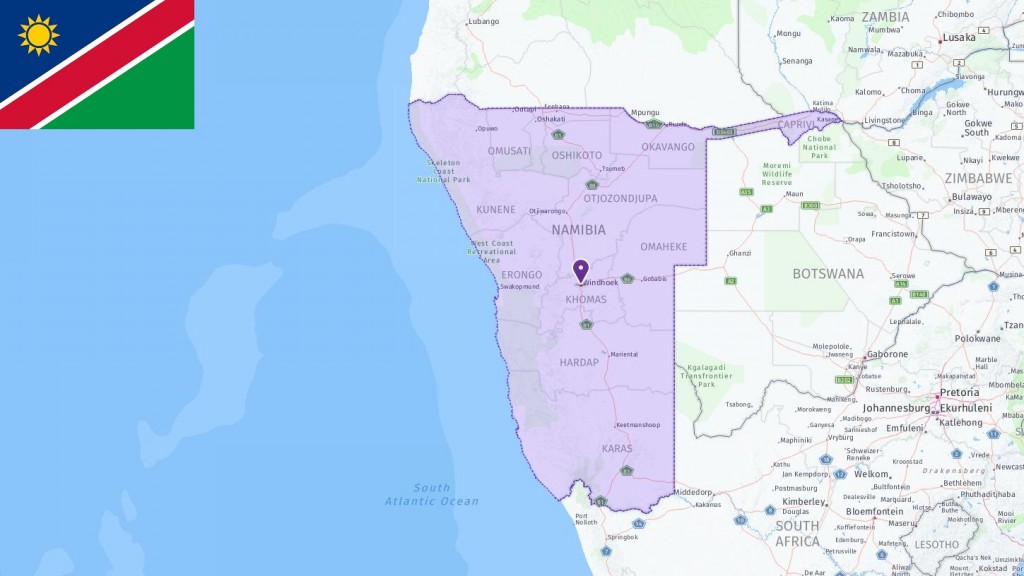NA is the abbreviation for Namibia, the 34th largest country in the world. Officially the Republic of Namibia, Namibia is a country located in Southern Africa, bordering 4 countries – Angola, Botswana, South Africa, and Zambia. Windhoek is the capital city of Namibia. Major cities include Windhoek (population: 268,121), Rundu (population: 58,161), Walvis Bay (population: 52,047), Oshakati (population: 33,607), Swakopmund (population: 25,036), Katima Mulilo (population: 25,016), Grootfontein (population: 24,088), Rehoboth (population: 21,366), Otjiwarongo (population: 21,213), and Okahandja (population: 20,868).
Country Profile
- Capital: Windhoek
- Language: English
- Area: 825,615 km2
- Population: 2,606,960
- Currency: Namibian dollar (NAD), South African rand (ZAR)
- Time zone: UTC+2
- Calling code: 264
- ISO 2-Letter Abbreviation: NA
- UN 3-Letter Abbreviation: NAM
- Internet TLD: .na
- State Government Website:
List of Namibia Acronyms
The most commonly used abbreviations about Namibia are NA which stands for Namibia and NAD which means Namibian dollar (Namibia currency). In the following table, you can see all acronyms related to Namibia, including abbreviations for airport, city, school, port, government, and etc.

Geography
Namibia is a large country with an elongated coastal strip of more than 160 km. To the east, the landscape turns into higher plateaus. More than a third of Namibia consists of desert areas. The dry Namibian desert extends into a thin belt along the entire coast. Along the country’s eastern border with Botswana, the vast Kalahari desert begins, and in the northern regions stretches elongated plains with sparse bush growth.
A few rivers intersect the otherwise arid landscape and create fertile areas. Most of the population lives here. Namibia has a very dry climate. It’s mostly hot all year. On the coast, cold ocean currents create a somewhat cooler climate, while temperatures inland vary widely.
The country is often hit by periods of drought, and it can go on for months without rain. The lack of clean drinking water is one of the country’s biggest environmental problems. The problem is compounded by the move into cities and the development of a water-intensive mining industry. The dry climate means that the sparse cultivable soil that exists is highly exposed to erosion and depletion.
History
The area has been inhabited by the nomadic San people since prehistoric times. From around year 0, other people groups from the region began to settle in the area. First the khoikhoi and the Nama people, and later the ladies and bantu.
In 1885 the area became a German colony under the name German South West Africa. The colonial power distributed most of the country’s resources to German immigrants, while the black population was banished to reserves and had to live on less than a quarter of the colony’s area. This led the Herero and Nama people to revolt. In 1904, the Germans fought hard on the uprising, killing more than 65,000 gentlemen and 20,000 Namas. This is known as the first genocide of the 20th century.
During World War I, Namibia was occupied by South Africa, which was mandated to govern the country by the League of Nations. The same apartheid laws that applied in South Africa were introduced in Namibia. The black population organized, and the South West Africa People’s Organization (SWAPO) waged a liberation war against South Africa for 24 years with UN support. In 1990, the country was finally able to adopt its own constitution, the SWAPO leader was elected president, and the country gained its independence.
Society and politics
Namibia is a democracy and a multi-party system republic. President heads the government, is head of state and military commander. Both parliament and president are elected for five years at a time.
SWAPO dominates the policy and has won all elections since independence by a good margin. The elections are considered free and fair. Initially the party was a socialist liberation movement, but now stands for national reconciliation and reconstruction, with the goal of creating a Namibian nation where ethnic divides play a minor role. Other important areas of focus are to improve the school system and health services.
The country’s authorities mainly respect the human rights of its citizens, and the judiciary is independent of political power. Like many neighboring countries in southern Africa, Namibia struggles to redistribute land owned by the white minority government during the colonial era. The country has some of the biggest income gaps in the world. The proportion of poor people has gone down in recent years, but every fourth inhabitant is still considered poor. Namibia is also severely affected by the HIV/AIDS epidemic.
Economics and Commerce
Namibia is rich in minerals and fishery resources, and these two industries dominate the economy. The country is among the world’s leading exporters of exclusive diamonds, silver and zinc. However, the income from the mineral industry is distributed very unevenly in the population, which still has sharp differences between whites and blacks. Most of the poor black villagers work in agriculture and produce for their own consumption.
Namibia’s economy has recovered well after the international financial crisis (2008-09), and has grown well in recent years. The country has less debt and lower corruption than many other countries in the region, but more challenges hamper economic development. Two reasons are a small domestic market and a lack of skilled labor. The country is struggling to create new jobs, and there is high unemployment, especially among young people.
Namibia has an open economy. The most important trading partner is South Africa. In recent years, the government has been trying to attract foreign investors to the country, and some industrial enterprises in textiles have been established.
View this article in other languages:
Deutsch – Français – 繁體中文


